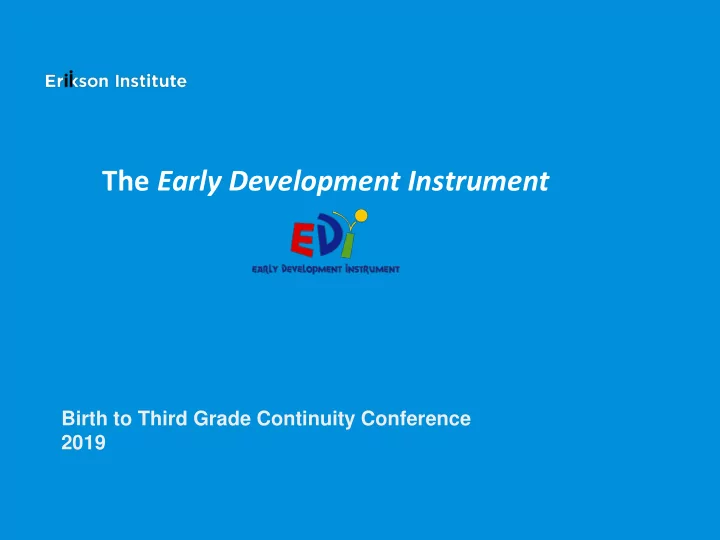

The Early Development Instrument Birth to Third Grade Continuity Conference 2019
Erikson Institute • Graduate School Community Partners • Continuing Education Direct Service • Research Policy and Leadership 2
What is the EDI? • Population measure • Community Needs Assessment • Kindergarten Census • Measures five developmental domains – holisti c • Survey of 103 questions- Presented as Maps/Tables • Completed by Kindergarten teachers • Typically administered triennially second half of year • Precise Data (Janus & Offord, 1997; Janus, Brinkman & Duku, 2011)
The Early Development Instrument Image: Human Early Learning Partnership, UBC
The EDI Does Not: • Report on individual children • Identify specific learning disabilities • Recommend special education or being held back • Inform teaching approaches or instruction • Reflect performance of school or quality of teaching (Janus & Offord, 1997)
Use of EDI Results Early Success in Developmental outcomes experiences school Inform Predict (Source: HELP)
The Pilot Years Partner Communities Greater East St. Louis Early Learning Partnership (n= 428) Success by 6 Coalition of Kankakee County (n= 691) • Bourbonnais (Village) • Bradley (Village) • Kankakee (City) Collaboration for Early Childhood of Oak Park (n= 618) Skokie/ Morton Grove (n= 463) Rockford (n= 2004) 7
And how are the children? “Kasserian ingera” Maasai Traditional Greeting
City of Rockford 3% 3% White Black/African 16% American Latinx 59% 19% Asian/Pacific Two or More Races Median Household Income: $41,991 (ACS, 2017) Unemployment: 8.0% (ACS, 2017)
How To: The Gallery Walk
How To… • Cross review materials (Map, table, metadata) • Discuss (use Inquiry questions) • Rotate
What is Meant by Vulnerable , At Risk , and On Track ? • On Track – Meeting developmental milestones expected for this age group and are expected to be successful in later grades. • At Risk – Not vulnerable but are lower than expected for this age. Considered “at risk” for becoming vulnerable and at risk continuing on a low achievement and health trajectory. • Vulnerable Children – Vulnerable for problems in later childhood. Without additional support and care, these children may experience future challenges in school and society.
Discussion • What stands out to you on the maps? • Where are the strengths and/or gaps located throughout the community? • Does this data confirm or counter your predictions? • What patterns do you see across the community? • What excites you about this data?
Let’s Walk
Data shine a light Image: Human Early Learning Partnership, UBC
Panel Discussion
Preguntas?
18
Next Steps Download our App Scroll Down to Community Data Initiatives and Select
Next Steps Think about Grant Opportunities – Use your EDI data – Use your county level data to support it
Generous support for the pilot project provided by:
Contact Information Jaclyn Vasquez Associate Director, EDI Erikson Institute graduate school in child development 451 North LaSalle Street, Chicago, Illinois 60654 O (312) 566-4474 | C (815) 343-7489 EDI@erikson.edu www.erikson.edu
Recommend
More recommend